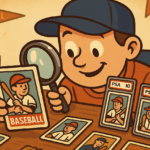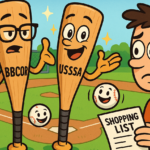Last Updated on May 11, 2025 by Matt Musico
Whether we’re talking about bats, gloves, batting gloves, or bags, all pieces of baseball equipment are important. But is there anything more important than a good pair of cleats? I mean, you have to wear them the entire time you’re on the baseball field. Getting the best youth baseball cleats can not only improve performance but also help prevent injury.
If you look for new cleats for a youth baseball player on the ol’ interwebs, though, there’s a good chance you’ll be overwhelmed with what you see. Who knows — maybe football cleats and soccer cleats somehow find their way into your search, making things even more overwhelming. And that’s without even thinking about the different colors and the wide range of available sizes.
There are a handful of key factors to consider, which we’ll detail below. After covering that, we’ll also point out different types of cleats, how to get the right size and fit, as well as maintain/extend the life of your spikes. I’ll also go over a handful of cleats that are popular and could be a good fit for your ballplayer to fully enjoy playing America’s pastime while on the diamond.
Disclaimer: This article includes affiliate links. We may receive a commission for any purchases made after clicking them. When making a purchase online, be sure to do enough due diligence before buying a product.
Key Factors to Consider for Youth Baseball Cleats
There are lots of things to think about when looking for boys baseball cleats. Many times, it’s very specific based on the ballplayer. What position do they play? What kind of surfaces will they be playing on? Do they have any pre-existing conditions to take into account?
However, the below three factors are typically universal when it comes to finding the right spikes.
Fit
This is probably the most important thing of all. It’s crucial to find a cleat with a comfortable fit. Wearing a pair that doesn’t fit right can be uncomfortable and possibly even lead to injury. You’ll want to find something that has a secure fit without being too tight. A good rule of thumb is to have the ability to wiggle your toes, as well as not having your heel slip out.
Also, do you want cleats with laces, Velcro, or zippers? The latter two can make it faster/easier to put on and take off, while the former could help with providing it a better overall fit.
Material
The material can impact a cleat’s durability, breathability, and weight. Synthetic materials are typically more affordable and durable, but they may not be as breathable and comfortable as leather. However, leather cleats may not last as long.
Molded cleats are usually more durable and provide better traction on dry fields. Metal cleats provide superior traction on wet or muddy fields. Of course, metal spikes may not yet be allowed in the league(s) you play in, so that’s a detail to confirm before moving forward.
Traction
Traction helps maintain stability and prevent slips/falls. The type of cleat pattern can affect the traction, and some patterns may be better for certain field conditions.
Rubber soles are known to be more durable and provide good traction on most surfaces. Plastic soles are typically more lightweight but may not provide as much grip.
Types of Youth Baseball Cleats
Metal vs. Molded Cleats
Metal cleats have superior grip, which makes them a popular choice for serious baseball players. Metal cleats are ideal for playing on grass or dirt fields where the ground can be soft and slippery.
Molded cleats have plastic or rubber spikes permanently attached to the sole of the shoe. These spikes are more lightweight and provide better ankle support. Molded cleats are a great option for players who play on multiple surfaces, like turf and dirt fields.
So when you’re trying to decide which type makes the most sense, think about the playing surface and your personal preference. Metal cleats are ideal for players who prioritize grip and performance, while molded cleats are ideal for players who prioritize superior comfort and versatility.
Turf Cleats for Practice
Turf cleats are a baseball shoe designed specifically for playing on artificial turf. They have shorter, rubber spikes that provide great grip on turf surfaces. They’re also a great option for practice since they can be worn on any surface without damaging the field.
In addition to the type of cleat, consider other factors such as grip, weight, and ankle support when choosing the right pair of youth baseball cleats. A good pair of cleats should give you enough grip to prevent slipping and be lightweight enough to allow for quick movements, all while providing enough ankle support to prevent injuries.
Finding the Right Size and Fit
Understanding Cleat Sizing
The first step in selecting the perfect shoe size is to simply measure your feet. Make it a point to measure both feet since they might be slightly different sizes. Place your foot on a piece of paper and trace around it. Measure the length and width of the foot and use a sizing chart to find the right size. Different brands may have slightly different sizing. So, it’s probably a good idea to try on the cleats before purchasing.
Adjustments for Optimal Fit
Once you know your size, you then need to make sure the cleats fit comfortably. They should fit snugly while not being too tight or too loose. You should have enough room in the toe box for your toes to move and wiggle comfortably. The length of a cleat is important for obvious reasons. Don’t neglect the width of your foot, though. Some cleats may be too narrow or too wide, which can lead to discomfort and affect performance.
Consider the following adjustments to make sure you have the best possible fit for your cleats:
- Laces: Make sure the laces are tied snugly, but not too tight.
- Insole: Adding an insole for extra cushioning and support might not be a bad idea.
- Socks: Avoid socks that are too thick or too thin since they can affect how well your cleats fit.
- Break-in period: Allow time for your cleats to break in. Wear them around the house for a few days before using them on the field.
Best Youth Baseball Cleats for 2025
Various styles of cleats could make sense for you and your needs on the baseball field. What’s important to remember is the perfect fit doesn’t always mean you buy the best seller or have to wear the most expensive cleats you can find. It’s totally up to you and your comfort level. Maybe you like high-cut baseball cleats, or maybe your playing style lends more to low tops. These are some of my favorites right now.
Nike Force Zoom Trout 9
If part of your game is speed on the bases, then the Nike Force Zoom Trout 9 cleats are a good choice. These are perfect for players who need a fast, lightweight cleat.
Adidas Adizero Impact Baseball cleats
The Adidas Adizero Impact Baseball cleats are designed with an aim toward lightweight speed and agility. It also offers an ample amount of breathability so your feet stay cool during games.
New Balance 4040 V7
The New Balance 4040 V7 cleats are popular among players who have a wide foot. While the design looks pretty sweet, these spikes also offer great traction and a comfy fit.
Mizuno Wave Lightrevo
Mizuno Wave Lightrevo cleats are known for comfort, but where they really make their money is the advanced cushioning and Wave technology that reduces impact. If on-field comfort is of the utmost importance, this is a solid choice.
Here are some other youth baseball cleats to consider that have been highly rated:
- CAMVAVSR Baseball Cleats: $29.99
- Guardian Baseball Youth High Top Baseball Cleats: $36.99
- Under Armour Boy’s Harper 8 TPU Jr. Baseball Shoe: $40.00
- New Balance Boys’ 3000 V6 Rubber Molded Cleat: $49.99
- Nike Alpha Huarache 4 Keystone Boy’s Rubber Baseball Cleats: $52.00
- New Balance FuelCell Romero Duo V2 TPU: $69.99
Maintaining and Extending Cleat Life
As a youth league baseball player, you want to get the most out of your cleats. Maintenance and care can help extend the life of your cleats.
Proper Cleaning Techniques
Keeping your cleats clean is essential for maintaining their appearance and performance. Dirt and debris can get trapped, which can cause them to wear down faster and reduce their grip. Here are some tips for cleaning your cleats:
- Brush off dirt and debris: Use a soft-bristled brush to remove dirt and debris from the cleats. Brush in all the crevices and grooves to remove any trapped dirt.
- Wipe down with a damp cloth: After brushing off the dirt, use a damp cloth to wipe down the cleats. This will help remove whatever is left that shouldn’t still be there.
- Air dry: Allow the cleats to air dry completely before wearing them again. Try to not use a heat source to dry them since that can damage the material.
Avoiding Common Wear and Tear
Youth baseball cleats are designed to withstand a baseball player getting to work on the diamond, but they can still wear down over time. Here are some tips for avoiding common wear and tear:
- Rotate your cleats: Wearing the same pair of cleats every game can cause them to wear down faster. Consider rotating between two or three pairs of cleats to extend their life if you’re able to own more than one pair at a time.
- Avoid wearing cleats off the field: Walking on hard surfaces like concrete or asphalt can cause the cleats to wear down faster. Avoid wearing your cleats off the field as much as possible.
- Store them properly: After each game or practice, store your cleats in a cool, dry place. Don’t leave them in direct sunlight or a hot car.
Get a Free Baseball Glove Guide!
Join the Bases Loaded Bulletin and a free digital copy of my Baseball Glove Buying Guide will land in your inbox shortly.
Instead of paying $9.97 for the ebook or $13.97 for the paperback book , it can be yours for free by signing up for my email list below.






Leave a Reply